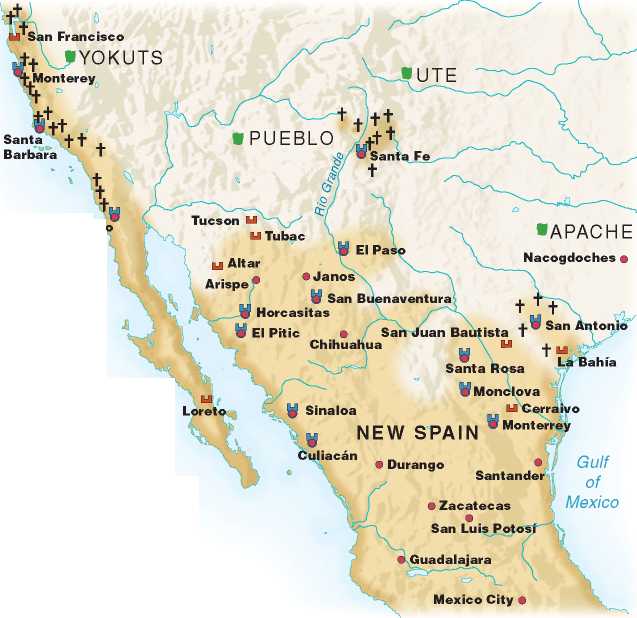Once the Indians of the upper Mississippi acquired guns from French traders, the new weaponry quickly spread to the Indians of the Great Plains. Far earlier, the Apache and Comanche had become experts at riding European horses, which proliferated on the vast grasslands in the heart of the continent. Now armed with light muskets, the Plains Indians became formidable foes; the Comanche were nearly invincible. Spanish raiders who had formerly seized Plains Indians for the slave trade now preyed upon less fearsome nomadic tribes, such as the Ute, who lived in the foothills of the Rockies.

Presidio with Town Mission Township Indian Tribes
Spain's North American Frontier, c. 1750 This map of Spanish settlement is somewhat deceptive: It shows a broad swath of land "under Spanish control” extending far north of New Spain, to Santa Fe, and to San Antonio. In fact, Spanish colonization in the northern regions was patchy, consisting of scattered religious missions and military garrisons. By 1750, Spanish colonists, Indian natives, and slaves had intermarried, changing the cultures of all.
Their hunting bands increased, the Comanche encroached on Apache territory. Soon Comanche warriors, occasionally assisted by French traders and soldiers, raided remote Spanish and Pueblo settlements in New Mexico and Texas. “We do not have a single gun,” declared one Spanish missionary in 1719,
“while we see the French giving hundreds of arms to Indians.” One recent historian refers to the emergence of a Comanche “empire.”
The new threat from marauding Indians and scheming Frenchmen prompted the Spanish to strengthen the presidio—fortified bases—at Santa Fe and San Antonio and to build new missions in east Texas. In an effort to preempt future attacks, the Spanish also dispatched a military expedition into Nebraska. But Pawnee Indians and the French ambushed and routed the invaders; from now on, Spanish garrisons and their Pueblo allies rarely ventured beyond their towns and missions.
The ascendancy of the Plains Indians endangered all of the new frontier missions and discouraged further settlement. In 1759 a Spanish commander of a presidio complained that the Comanche were “so superior in firearms as well as in numbers that our destruction seems probable.” San Antonio, the largest town, had only 600 Hispanic settlers.
The trade in Indian slaves remained an enduring aspect of life along the sparsely populated northern rim of New Spain. Catholic missionaries usually prevented Spanish traders from enslaving Pueblo Indians, many of whom lived in mission towns and knew the rudiments of Catholicism. But no such arguments could protect the “wild” Indians such as the Ute of the foothills of the Rockies.
Because adult males resisted capture and incorporation into colonial society, most Indian slaves were women and children. In 1761 Father Pedro Serrano reported that at one New Mexican trade fair Indian women over the age of ten were raped “in the sight of innumerable assemblies of barbarians and Catholics” before they were sold.
Indian slaves often had children by Hispanic fathers, who rarely acknowledged these offspring. Known as genizaros, these children occupied the bottom rung of a social system largely based on the status of fathers. Genizaros learned Spanish and received training in Catholicism. In some towns, they comprised a third of the population. Females usually worked as household servants, and males, as indentured servants on ranches. Spanish officials, eager to increase the numbers of Spanish colonists, granted genizaros the right to own property. Many became ranchers and herders.
While the Comanche terrorized the frontier of New Mexico and Texas, Spanish officials learned of a new threat in the 1760s: Britain and Russia were attempting to colonize the Northwest, the region that now comprises Oregon and Washington. This threatened Spain’s claims to California, a remote wilderness inhabited by some 300,000 Indians. As in New Mexico, Spain failed to attract Hispanic settlers; so it invited Franciscan missionaries to create “Spanish” settlers by converting the Indians to Catholicism and Hispanicizing their language and culture. This did not prove easy. The Indians of California belonged to over 300 tribes that spoke nearly 100 different languages.
In 1769 several score Jesuits and a detachment of Spanish soldiers established a presidio and mission in San Diego. Other missions followed at Monterey, Santa Barbara, and San Francisco; within several decades some twenty missions had been established in California.
The Jesuits monitored Indian life closely. They segregated all unmarried girls over the age of seven so as to prevent them from indulging in freer Indian sexual mores and to protect them from lustful European men. The Jesuits also inculcated the discipline of work; the digging of irrigation ditches; the cultivation of crops; the tending of livestock; the manufacture of handicrafts; and the construction of churches, forts, and homes. The Indians received no wages, but instead were fed and cared for by the priests, whose first obligation was to God and the church. Because the California settlements were distant from New Spain, the missions survived chiefly by provisioning Spanish military garrisons.
Whatever success the Jesuits had in establishing the missions, however, was undone by disease. As had happened throughout the Western Hemisphere, the introduction of European pathogens among formerly isolated Indian populations resulted in catastrophic losses. European diseases hit all California Indians, not just those in the missions. By the close of the eighteenth century, Spain had failed in its effort to establish a strong Hispanic colony in California.




 World History
World History









